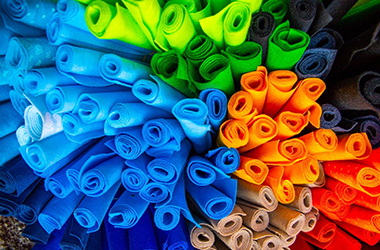Non-woven products are rich in color, bright and bright, fashionable and environmentally friendly, widely used, beautiful and generous, with various patterns and styles, and are lightweight, environmentally friendly, and recyclable. They are internationally recognized as environmentally friendly products that protect the earth's ecology. Suitable for agricultural film, shoe-making, tanning, mattresses, quilts, decoration, chemicals, printing, automobiles, building materials, furniture and other industries, as well as clothing interlinings, medical and health disposable surgical gowns, masks, caps, bed sheets, hotels Disposable tablecloths, beauty, sauna and even today's fashionable gift bags, boutique bags, shopping bags, advertising bags and more. Environmentally friendly products, versatile and economical. Because of its appearance like pearls, it is also called pearl canvas.

Nonwoven fabrics are made of chemical fibers and plant fibers on a wet or dry paper machine with water or air as a suspending medium. Although they are cloth and not woven, they are called non-woven fabrics. Non-woven fabric is a new generation of environmentally friendly materials, which has the advantages of good strength, breathable and waterproof, environmental protection, flexibility, non-toxic and tasteless, and low price. It is a new generation of environmentally friendly materials with the characteristics of water repellency, breathability, flexibility, non-combustion support, non-toxic and non-irritating, and rich colors. If the material is placed outdoors and decomposed naturally, its longest lifespan is only 90 days. When placed indoors, it will decompose within 8 years. It is non-toxic and harmless when burning, so it does not pollute the environment.
Applications
(1) Non-woven fabrics for medical and sanitary use: surgical gowns, protective clothing, disinfection wraps, masks, diapers, civilian wipes, wipes, wet face towels, magic towels, soft towel rolls, beauty supplies, sanitary napkins, sanitary napkins Pads, and disposable sanitary cloths, etc.
(2) Non-woven fabrics for home decoration: wall coverings, tablecloths, bed sheets, bedspreads, etc.
(3) Non-woven fabrics for clothing: linings, adhesive linings, flakes, shaped cotton, various synthetic leather base fabrics, etc.
(4) Non-woven fabrics for industrial use; base materials, reinforcing materials, polishing materials, filter materials, insulating materials, cement packaging bags, geotextiles, and covering cloths for roofing waterproofing membranes and asphalt shingles.
(5) Agricultural non-woven fabrics: crop protection fabrics, seedling raising fabrics, irrigation fabrics, thermal insulation curtains, etc.
(6) Other non-woven fabrics: space cotton, thermal insulation and sound insulation materials, linoleum felt, cigarette filters, tea bags in bags, shoe materials, etc.
Medical and hygiene: surgical gowns, caps, hoods, gypsum cotton wool, women's sanitary napkins, baby diapers, wet face wipes, sanitary underwear, dust cover, masks.
Agriculture: Harvest cloth, greenhouse cloth.
Industry: floppy disk lining, speaker cloth, filter material, sound box sound insulation felt, sealing ring lining, cable cloth, glass fiber reinforced plastic towel, industrial wipe, shockproof liner, insulating material, tape base lining, pipe base lining, ventilation duct, Sharpie cloth.
Packaging: composite cement bag, luggage lining, packaging base lining, quilt, storage bag, mobile jacquard luggage.
Clothing and shoe-making: Garment lining, flakes, toe lining, heel lining, underwear, artificial deerskin, synthetic leather, warm shoe lining, cloth sole lining.
Automotive industry: waste spun thermal insulation felt, shockproof felt, headliner, seat cushion lining, carpet, door lining, automotive filter element, molded seat cushion.
Household clothing: sofa inner wraps, carpets, wall coverings, mirror cloths, tea bags, vacuum cleaner filter bags, shopping bags, printed sheets, entertainment covers, cushions, sleeping bags, dry cleaning cloths, scouring pads, curtains, tablecloths, Lampshade, the back of the Mito seat is covered with film.
Civil Engineering, Construction: Reinforcement, Reinforcement, Filtration, Linoleum Base Fabric, Drainage Board, Roof Waterproofing, Railway, Highway, Berm, Water Slope, Port Soundproofing, Sewer, Heat Protection, Separation, Drainage.
Other uses: launch vehicles, missile head heat-proof cones, nozzle throat linings, high-grade money printing paper, space shuttle heat-resistant tiles, map cloth, calendar cloth, artificial cloth, oil painting cloth, etc.
Maintenance
Maintenance of non-woven fabrics: The following points should be paid attention to in the maintenance and collection of non-woven fabrics:
1. Keep it clean and wash it frequently to prevent the growth of moths.
2. When storing in different seasons, it must be washed, ironed, dried, sealed in a plastic bag, and placed flat in the wardrobe. Pay attention to shading to prevent fading. It should be often ventilated, dusted and dehumidified, and not exposed to the sun. Anti-mildew and moth-proof tablets should be placed in the wardrobe to prevent cashmere products from being damp and mouldy.
3. The lining of the matching coat should be smooth when worn inside, and hard objects such as pens, key bags, mobile phones, etc. should not be placed in the pockets to avoid local friction and pilling. Minimize friction with hard objects (such as sofa backs, armrests, table tops) and hooks when wearing them. It is not easy to wear for too long, and it must be stopped or changed for about 5 days to restore the elasticity of the clothes to avoid fiber fatigue damage.
4. If there is pilling, do not pull it forcibly. Use scissors to cut off the pom-pom, so as not to be repaired due to off-line. There is also non woven fabric slitting machine at SUNTECH. Any interest, click to discover more.




